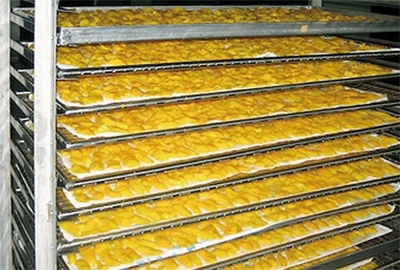The dried mango industry, however, is facing stiff competition from its ASEAN neighbors notably Thailand. The growth of the local fruit processing industry, particularly mangoes is stymied by high production costs and short supply.

Erwin Siao of R&M preserves, the pioneers of dried mango processing, said the high acquisition cost of green mangos is forcing manufacturers to sell Philippine dried mangos as a high end product which makes it difficult to compete with similar products from other countries.
“There is a big market that can be tapped as far as the international market is concerned. There is still much growth there but due to the number of competitors, not just locally but internationally, the price issue comes into play,” he said.
Siao used Thailand as an example, saying that while Thailand’s dried mango products might be of lesser quality than those produced in the Philippines, the more attractive packaging and lower prices make Thai mangoes more attractive to the international market. “Thailand has the edge over the Philippines in dried mango production not just in packaging, but in terms of price. If you were to look at how Thailand fruit processors positions themselves, all the dried fruit processing plants are situated in an export zone that is no more than 5 kilometers from the plantation. Therefore, your transportation and operational costs are low,” he explained.
This is in stark contrast to how fruit processors operate in the Philippines. Cebu serves as the dried mango capital of the Philippines but due to the fact that the province is an island, there is a lack of agricultural land which can serve as mango plantations to address the supply requirements of processing plants.
This forces a big majority of the larger processed fruit companies to source their raw fruit supply from different plantations all over the country, depending on the time of the year since different parts of the country have different harvesting months.
The development of better infrastructure such as farm to market roads would help in lowering acquisition costs. However, the high inter-island shipping costs will continue to affect production costs which will result in higher end-product prices.
“We still need the infrastructure. We don’t have enough farms, farm to market access is difficult or non-existent. Our partner supplier’s farmers have to walk long distances to harvest the fruits. The fruits are then collected and brought by trucks to the city. From the city, they transport the fruits by boat to our plants here in Cebu."
By the time the material reaches our plants transport costs alone have gone up so high leaving our product less competitive, he said.
This means that Philippine-made dried mangos cannot compete with dried mangos from another country from a price standpoint,” Siao said.
When asked if the construction of processing plants closer to plantations would help lower costs, Siao disagreed, saying that the cost of constructing a plant will not make the industry financially feasible.
“A company would need to spend millions of pesos for the construction of the plant. Purchase of equipment is an even bigger cost item. On top of all that is the additional cost of training a staff and workers," Siao said.
It is not feasible to invest so much money on just one processing plant just to offset the cost of transportation from one or two plantations in the area,” he said.
Another issue that has hampered the growth of Philippine dried mango in the international market is the lackluster packaging compared to the country’s competitors. “Look at Vietnam right now. Its industry has grown so much, its packaging has improved tremendously at a very minimal cost. Here in the Philippines, if you want to have nice packaging, you pay the price. You have your design, your color separation done either locally or abroad, but when you have to print it, you go to expensive printing presses which can only be found in Manila,” Siao said.
Despite these issues, Siao remains optimistic that Philippine dried mango industry can compete in the international market. “You just have to fight it out. You need to educate the buying public that yes, Philippines dried mango is more expensive than the competitor, but you pay for the quality,” Siao said.







